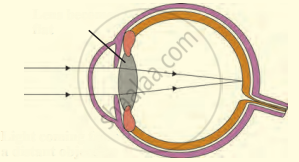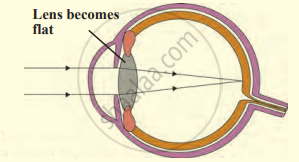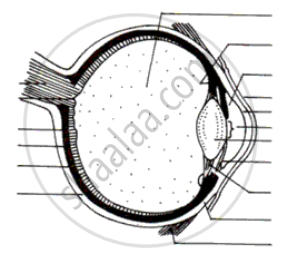Advertisements
Advertisements
प्रश्न
The following figure show the change in the shape of the lens while seeing distant and nearby objects. Complete the figures by correctly labelling the diagram.

उत्तर
Light coming from a distant object-

APPEARS IN
संबंधित प्रश्न
Define the term.
Power of accommodation of the eye.
What changes the shape of lens in the eye?
Give the scientific names of the following parts of the eye:
a clear window at the front of the eye.
What change is made in the eye to enable it to focus on objects situated at different distances? Illustrate your answer with the help of diagrams.
Why does it take some time to see objects in a dim room when you enter the room from bright sunshine outside?
Ciliary muscles of human eye can contract or relax. How does it help in the normal functioning of the eye?
Suggest how your irises help to protect the retinas of your eyes from damage by bright light.
When is a person said to have developed cataract in his eye? How is the vision of a person having cataract restored?
Fill in the following blank with suitable word:
Having two eyes enables us to judge.................more accurately.
Name the following:
The part of the eye responsible for its shape.
Differentiate between members of the following pair with reference to what is asked in bracket.
Rod and cone cells (pigment contained)
Mention if the following statement is true (T) or false (F) Give reason.
Blind spot is called so because no image is formed on it.
State the main functions of the following:
Coronary Artery
Label the following diagram :

Give the main function of the following:
Lachrymal glands
Sketch and label V.S. of a human eye.
Name the following:
The pigmented circular area seen in the eye.
Name the following:
The most sensitive region of the retina.
Name the following:
The focal length of the lens is altered by the contraction of which type of muscles.
Mention, if the following statement is True or False
Cones are the receptor cells in the retina of the eye sensitive to dim light.
State the Function:
Iris
State the Function:
Conjunctiva
Write the name.
The part of human eye that transmits electrical signals to the brain.
The image of an object at an infinite distance is obtained in a real and erect form through a convex magnifying glass.
Write an Explanation.
Farthest distance of distinct vision
Write the function of the human eye and label parts of the figure given below.

A student sitting on the last bench can read the letters written on the blackboard but is not able to read the letters written in his text book. Which of the following statements is correct?
Boojho while waving his hand very fast in front of his eyes, observes that his fingers appear blurred. What could be the reason for it?
What kind of lens is there in our eyes? Where does it form the image of an object?
Which part of the eye gets affected if someone is suffering from cataract? How is it treated?
Write down the names of parts of the eye in the blank spaces shown in the figure.

In human eye the part which allows light to enter into the eye is ______.
Match the following:
| Column - I | Column - II |
| 1. Retina | a. Path way of light |
| 2. Pupil | b. Far point comes closer |
| 3. Ciliary muscles | c. near point moves away |
| 4. Myopia | d. Screen of the eye |
| 5. Hypermetropia | e. Power of accommodation |
Vitreous humour is present between ______.
Match the following:
| Column - I | Column - II |
| 1. Retina | a. Path way of light |
| 2. Pupil | b. Far point comes closer |
| 3. Ciliary muscles | c. near point moves away |
| 4. Myopia | d. Screen of the eye |
| 5. Hypermetropia | e. Power of accommodation |
State the functions of the following:
Ciliary muscles
Write in proper sequence the names of all the parts of the human eye through which the light rays coming from an object pass before they form an image on the retina.
Name the following:
Place of no vision in the retina of the eye.
With reference to human eye answer the question that follow:
Name the part of the eye associated with the layer providing nourishment to the eye.
